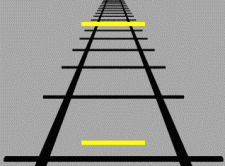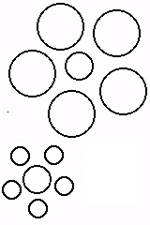
 Chen Song, Samuel Schwarzkopf and Geraint Rees of University College London used some common visual illusions to investigate how the visual cortex processes information about object size.
Chen Song, Samuel Schwarzkopf and Geraint Rees of University College London used some common visual illusions to investigate how the visual cortex processes information about object size. The two types of illusions they used are known as the Ponzo illusion (pictured left) and the Ebbinghaus illusion (pictured right). In the former illusion, objects that seem to be more distant appear larger than identically sized objects that seem to be closer, and in the latter illusion, identically sized central objects appear to be of different sizes depending on the size of the surrounding objects.
The researchers devised the two illusions so that the identically sized test objects (central circles or horizontal bars) could be displayed to either one eye, or separately to two different eyes. Six volunteers were asked to look through the apparatuses and give information about the perceived size of the test object (circle or bar) as compared to the reference object. The Ponzo illusion (horizontal bars) was just as effective regardless of whether one or two eyes received the information, but the Ebbinghaus illusion (circle sizes) became much weaker when the circles were seen by different eyes.
The authors suggest that two different mechanisms are at work in interpreting the visual signals from the illusions. The Ponzo illusion relies on assumptions about depth and distance in three dimensions, whereas the Ebbinghaus illusion is based on a simple size comparison. For this reason, the two illusions may be dependent on different types of neurons, specifically binocular versus monocular neurons.
No comments:
Post a Comment